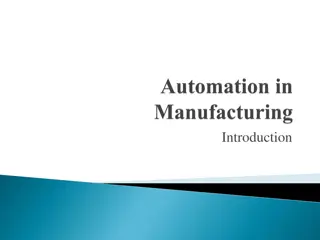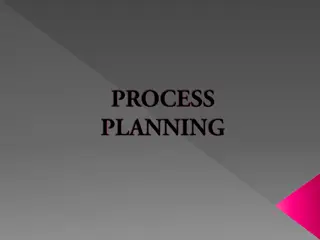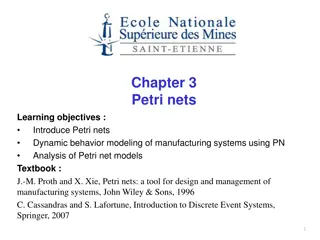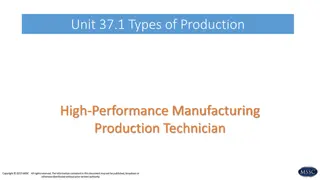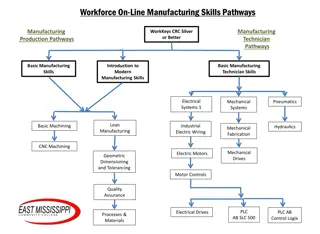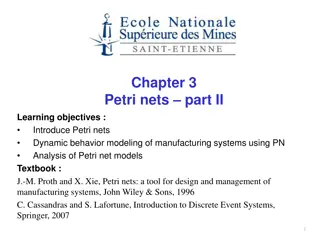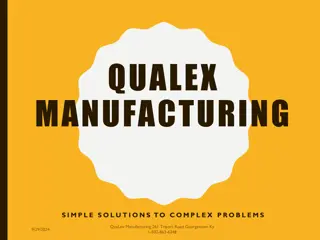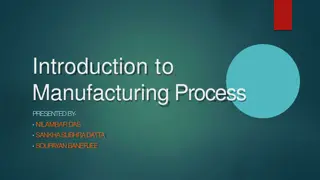Understanding IDEF1X Data Modeling in Manufacturing Systems
Explore the world of IDEF1X data modeling in manufacturing systems, from components of information to the benefits of analysis. Learn why developing an IDEF1X model is crucial for information resource management and how it helps in achieving a competitive edge. Discover what an IDEF1X model is and how it differs from a traditional data model, focusing on logical designs of databases and applications. Enhance your knowledge of data modeling and its applications in the context of manufacturing systems.
Download Presentation

Please find below an Image/Link to download the presentation.
The content on the website is provided AS IS for your information and personal use only. It may not be sold, licensed, or shared on other websites without obtaining consent from the author. Download presentation by click this link. If you encounter any issues during the download, it is possible that the publisher has removed the file from their server.
E N D
Presentation Transcript
IE 469 Manufacturing Systems 469 IDEF 1X Data Modeling
Components of Information Information Data Meanings Facts
From ER to IDEF1X M M Customer Selling Product Selling Customer Product
IDEF 1X Useful in determining when information voids are the cause of a problem Consistent, extensible, and transformable Provides consistent mapping and definition of enterprise data
Benefits of IDEF1X Analysis Separate Facts from Folklore Discover underlying cause for problems Use directly as requirements Implement results with policy or procedure change Designed for the domain expert
Why Develop an IDEF1X Model? Determine information resource management needs and requirements Depict what information is collected, stored, and managed Depict the rules governing the management of information Validate the concepts in the associated IDEF0 model Leverage information to achieve a competitive advantage
What is an IDEF1X Model? A Graphic / Textual Depiction of What Must I Know to Do What I Do? Automated and Non-Automated Objects People Filing Cabinets Telephones Sale / 2 ABC Mailbox / 6 Sale # ABC ID Decreases Count of Receives Invoices from P Item on Shipment / 7 Vendor # (FK) Shipment #(FK) Shipment / 4 Item / 1 Vendor / 5 Vendor # (FK) Shipment # Item # Vendor # (FK) Vendor # 1 P Contains Increases Count of P Prepares P Owns 1 Vendor Mailbox / 3 Vendor # (FK) Receives count of
What is a Data Model? A Representation of the Data Elements and the Relationships among those Elements in an Existing or Planned System.
Data Modeling Focus Things inside the computer/software system Representation & structure of DATA Use for logical design of databases logical design of applications physical design of database implementation
Information Modeling Focus Information collected, stored, and managed by the organization Rules within the organization about that information Logical relationships within the organization reflected in the information Basis for information system design Use for Problem Identification Requirements Definition
Knowledge Modeling Focus Terminology used in the domain to represent concepts, physical objects, behavior or knowledge that people use to do their job Concepts people use to do their job Perceived relationships within the organization Physical (Nomic) Constraints Conventional (Nominative) Constraints Conditional Constraints Map of language use on the real world The flow of knowledge between situated agents in the environment
Information Modeling Use Information System Audit systems machines & software Document Flow Analysis Which organizations generate Which organizations use Data Life-Cycle Definition Data Flow Modeling
IDEF1X - Data Modeling Intended as a method to facilitate the logical design of a relational database, IDEF1X provides: a foundation for a data dictionary. a definition of the information and data structure of the enterprise. a model that can be used in actual database implementation. SQL code generated through commercial product support.
IDEF1X As A Standard Federal Information Processing Standards Publication (FIPS PUB) 184 - Integration Definition for Information Modeling (IDEF1X) Published December 1993 DoD 8020.1-M established IDEF1X as the DoD standard methodology used for data modeling
"Real World" Connections Information Model Business Rules The Real World VENDOR Any individual vendor may receive many purchase orders. Information about Vendors Any individual purchase order is issued to only one vendor. Information about Purchase Orders Purchase Order
Entity A generic name of a person, place, or thing that is within the scope of the model and has a unique identifier. Employee is an entity and has a unique identifier (employee number).
Entities Instances of entities Dick Schwartz John Jones Employee Entity
What Makes a Set of Things an Entity? Can it be described? Are there several instances? Can one instance be separated or distinguished from another? Does it refer to or describe something? (If YES, then it may be an attribute of an entity.)
Attribute A type of characteristic or property associated with a set of real or abstract things (people, objects, events, etc.). Attribute Instance Is a specific characteristic of an entity. Is defined by both the types of a characteristic and its value. Has a unique name (noun/noun phrase), and the same meaning must always apply to the same name. May be inherited by an entity through a specific connection or categorization relationship in which it is a child or category entity.
Attributes: An Example Entity (employee) Instance of an Attribute Attributes No. 1: NAME: Smith JOB: Operator Employee No. No. 2: NAME: Jones JOB: Supervisor Employee Name No. 3: NAME: Starbuck JOB: Pilot Employee Job
Attributes Hair Color Gender Employee Number 16482 F Brn 25 13258 M Red 18 Employee Number Gender Hair Color Age Age Employee
Entities and Attributes Vendor/1 P.O./2 vendor_name vendor_number contact_number address phone_number po_total po_number P Account Item/3 status due_date invoice_date invoice_number
Keys Primary Key Attribute whose value uniquely identifies every instance of the entity. Alternate Key Attribute whose value uniquely identifies the entity, but is not the primary key. There can be more than one. Foreign Key Attribute that appears in a dependent entity, having migrated from the primary key of its parent entity.
Primary Key Attribute and Primary Key Syntax Entity-name/Entity-number Primary Key Attributes } Other Attributes Owned or Inherited }
Primary Key Vendor/1 vendor_number P.O./2 po_number vendor_name contact_number address phone_number po_total P Account Item/3 status due_date invoice_date invoice_number
Alternate Key Every entity must have a unique key formed from one or more attributes. If more than one unique key exists only one is the primary key, the others are alternate keys. A primary key may serve as part of an alternate key. Example: Employee/2 Primary Key Employee-No Alternate Key #1 Alternate Key #2 SSN (AK1) Name (AK2) Birth Date (AK2)
Foreign Keys Vendor/1 vendor_number P.O./2 po_number vendor_name contact_number address po_total phone_number P Account Item/3 po_number (FK) vendor_number (FK) status due_date invoice_date invoice_number
Relationships A meaningful association or connection between two entities. A business rule.
IDEF1X Relationships All decisions are determined in pairs! Entity Classes Related Pairs
IDEF1X Component Relations Relations show the association and dependency between Entity Classes. Each relationship is labeled with a verb phrase. Examples is assigned to has The dependency between two entity classes determines the syntax of the label and the way it is depicted is contained in performs
Types of Relationships in IDEF1X Non-specific Relationships Categorization Relationships Complete Categorization Generic Entity Entity 1 Entity 2 Discriminator Specific Relationships Entity 1 Entity 2 Identifying Relationship Entity 1 Entity 2 Incomplete Categorization Generic Entity Non-Identifying Relationships Discriminator Entity 1 Entity 2 Entity 1 Entity 2
IDEF1X Component Relations An entity class which can not meaningfully exist without the existence of another entity class is said to be dependent. Example: a Purchase Order can not exist without a Purchaser. Relations are depicted and labeled from the independent entity class towards the dependent entity class. Often non-specific dependencies must be shown and resolved later. These are always given bi- directional labels.
Non-Specific Relationship Many-to-Many relationship between two and only two entities. Cardinality is expressed in both directions. The relationship is named in both directions. RELATIONSHIP OF A TO B Entity A/1 Entity B/2 Relationship Name/ Relationship Name RELATIONSHIP OF B TO A
Specific Relationship Parent-child or Existence-dependency. One parent exists for zero, one, or more instances of the child. Each instance of a child entity can exist only if an associated instance of the parent entity exits. Relationships may be identifying or non- identifying.
Key Class Migration Refers to the inheritance of key class attributes from an independent entity class to a related, dependent entity class. Stabilizes functional dependency. Causes refinement of model to next lower level of detail.
Key Class Migration Requires resolution of Non-Specific Relation Class syntax first Migrates from Independent to Dependent Entity Class Occurs once for each Relation Class shared by an Entity Class pair Non-Key Attribute Classes NEVER Migrate.
Identifying Relationship The unique identification of an instance of the child depends upon knowing the identity of the associated instance of the parent. The child entity in an identifying relationship is always an identifier-dependent entity. RELATIONSHIP NAME FROM PARENT TO CHILD PARENT ENTITY CHILD ENTITY Entity A/1 Entity B/2 Key-Attribute-B Key-Attribute-A Relationship Name Key-Attribute-A (FK) IDENTIFYING RELATIONSHIP INDICATOR
Non-Identifying Relationship The unique identification of the instance of the child does not depend upon knowing the identity of the parent instance. The child entity will be an identifier-dependent entity unless it is also a child entity in an identifying relationship with some other entity. RELATIONSHIP NAME FROM PARENT TO CHILD CHILD ENTITY PARENT ENTITY Entity A/1 Key-Attribute-A Entity B/2 Key-Attribute-B Relationship Name Key-Attribute-A (FK) NON-IDENTIFYING RELATIONSHIP INDICATOR
Cardinality of Relationships Identifying Relationships Non-Identifying Relationships One To Zero or More One To Zero or More One To One or More One To One or More P P One To Zero or One One To Zero or One Z Z One To Exactly N One To Exactly N N N
Cardinality P.O./2 Vendor/1 P Account Item/3
Complete Categorization Generic Entity The generic entity may be identifier-independent or identifier-dependent. Discriminator Category entities are always identifier-dependent. Category Entities
Incomplete Categorization Discriminator
Categorization Migration Account Item/3 po_number(FK) vendor_number (FK) due_date invoice_number invoice_date status status Billed/8 Overdue/7 po_number (FK) vendor_number (FK) Paid/6 po_number (FK) vendor_number (FK) po_number (FK) vendor_number (FK) overcharge_due date_received check_number
IDEF1X Glossary In IDEF1X, a glossary of entities, attributes, and sometimes relations must be documented. A diagram tells only half the story textual content tells the other half. Why does the department have access or use of employees instead of assigning them to a department for that department s exclusive use?
IDEF1X Project Members Project Manager Modeler (Author) Expert Source Expert Reviewer Librarian
Getting Started Establish Viewpoint, Purpose, & Context Context is most important Five-phase process Designed as a discovery process Not sequential in phase application Designed to be tolerant of error Phases are really skill categories
IDEF1X Phased Approach Phase 0 - Context Definition Phase 1 - Entity Class Definition Phase 2 - Relation Class Definition Phase 3 - Key Class Definition Phase 4 - Attribute Class Population
Phase 0 Align Information Model Purpose Supplements and balances other aspects of the project Organize Team (modelers, experts, stakeholders) Determine data collection techniques to be used and develop Data Collection Plan Identify and maintain Source Data List (SDL) Establish Model conventions
Phase 0 Example 1. Purpose: Identify information that no longer needs to be maintained due to organizational changes. 2. Data Collection Plan: Specify approach to obtain and model data, including data collection techniques (interviews, documentation reviews, etc.). 3. Source Data List: Data List Report. 4. Conventions: Entity & Attributes will be capitalized and hyphenated.
Phase I: Identify Entities Identify candidate entity classes Examine physical documents, interview results, associated IDEF0 Activity Models; and/or IDEF3 Process Models Assign entity class ID number Define glossary for entity classes Identify & define Entity Class synonyms Separate candidate entities from model entities relative to the project purpose


